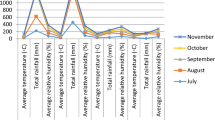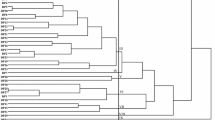Abstract
Progeny studies of Jatropha curcas and Pongamia pinnata were carried with respect to bioproductivity, pod and seed characters which is one of the selection methods in tree improvement programmes. Variations in bioproductivity and biodiesel parameters of both the plants were compared every 6 months for 4 years of investigation and analyzed by analysis of variance and correlation coefficient by Pearson’s method using software Graphpad instat 3.06 (for Windows and Mac). P. pinnata has better germination rate (71.4 %), 100 pod weight (PW) (311.59 g) and 100 seed weight (SW) (173.46 g) as compared to J. curcas for germination rate (43.2 %), 100 PW (111.29 g) and 100 SW (67.46 g). P. pinnata has strong correlation for plant height to canopy growth (CG) (0.948), collar diameter (CD) (0.994), number of branches per plant (NBP) (0.995) and to number of leaves per branch (NLB) (0.862) as compared to J. curcas which showed good correlation among plant height to CG (0.976), CD (0.970), NBP (0.988), NLB (0.920) and to number of pods per branch (0.657). However, J. curcas depicted negative correlation for pod breadth to seed length (SL) (−0.447), seed breadth (−0.248) and to seed thickness (ST) (−0.364) and among the 100 PW to SL (−0.199), ST (−0.220) and to 100 SW (−0.704). About 4 kg of P. pinnata seeds were required for each liter of crude oil which yields 896 ml of biodiesel on transesterification as compared to 5.66 kg of J. curcas seeds for a liter of crude oil, producing about 663 ml of biodiesel. The quality of biodiesel meets the major specification of American Society for Testing and Materials (ASTM) standards for biodiesel. The crude glycerin and seed cake obtained as byproduct during biodiesel production were also measured which can be purified and used in composting, animal feeds, pharmaceuticals and cosmetic industries.
Similar content being viewed by others
References
Akpan UG, Jimoh A, Mohameed AD (2006) Extraction, characterization and modification of castor seed oil. Leonardo J Sci 8:43–52
Azam MM, Amtul-Waris Nahar NM (2005) Prospects and potential of fatty acid methyl esters of some non-traditional seed oils for use as biodiesel in India. Biomass Bioenergy 29:293–302
Dash AK, Pradhan RC, Das LM, Naik SN (2008) Some physical properties of simarouba fruit and kernel. Int Agrophysics 22(2):111–116
Divakara BN, Das Rameshwar (2011) Variability and divergence in Pongamia pinnata for further use in tree improvement. J Forestry Res 22(2):193–200
Hideki F, Kondo A, Noda H (2001) Biodiesel fuel production by transesterification of oils. J Biosci Bioeng 92:405–416
India foreign trade (2013–2014) RBI monthly bulletin, August 2014
Karmee SK, Chadha A (2005) Preparation of biodiesel from crude oil of Pongamia pinnata. Bioresour Technol 96:1425–1429
Kaura SK, Gupta SK, Chowdhury JB (1998) Morphological and oil content variation in seeds of Azadirachta indica A Juss. (neem) from northern and western provenances of India. Plant Foods Hum Nutr 52:121–128
Kaushik N, Kumar S, Kumar K, Beniwal RS, Kaushik N, Roy S (2007) Genetic variability and association studies in pod and seed traits of Pongamia pinnata (L.) Pierre in Haryana, India. Genet Resour Crop Evol 54:1827–1832
Kumar S, Gupta AK, Naik SN (2003) Conversion of non-edible oil into biodiesel. J Sci Ind Res 62:124–132
Kumaran K (1991) Genetic analysis of seed and juvenile seedling attributes in neem (Azadirachta indica A. Juss.) and pungam Pongamia pinnata (Linn.) Pierre. M.Sc. Thesis. Tamil Nadu Agricultural University, Coimbatore, India
Ma FR, Hanna MA (1999) Biodiesel production: a review. Bioresour Technol 70(1):1–15
Manonmani V, Vanagamudi K, Vinaya Rai RS (1996) Effect of seed size on seed germination and vigour in Pongamia pinnata. J Tropical For Sci 9:1–5
Puhan S, Vedaraman N, Rambrahamam BV, Nagarajan G (2005) Mahua (Madhuca indica) seed oil: a resource of renewable energy in India. J Sci Ind Res 64:890–896
Rao TV, Rao GP, Reddy KH (2008) Experimental investigation of Pongamia, Jatropha and neem methyl esters as biodiesel on C. I. engine. Jordan J Mech Ind Eng 2(2):117–122
Srivastava PK, Verma M (2008) Methyl ester of Karanja oil as an alternative renewable source energy. Fuel 87:1673–1677
Subramanian AK, Singal SK, Saxena M, Singhal S (2005) Utilization of liquid biofuels in automotive diesel engines: an Indian perspective. Biomass Bioenergy 9:65–72
Sunil N, Varaprasad KS, Sivaraj N, Suresh Kumar T, Abraham B, Prasad RBN (2008) Assessing Jatropha curcas (L) germplasm insitu—a case study. Biomass Bioenergy 32:198–202
Surendran C, Sehgal RN, Paramatma M (2003) Textbook of forest tree breeding. Indian Council of Agricultural Research, New Delhi, p 247
Tyagi OS, Atray N, Kumar B, Datta A (2010) Production, characterization and development of standards for biodiesel—a review. J Metrol Soc India 25(3):197–218
Vasav VP, Narkhede SS, Rane AD, Gunaga RP, Rewale AP, Bhave SG (2011) Evaluation of progenies of candidate plus trees of Pongamia pinnata (L.) Pierre. for seed germination and seedling vigour. Curr Sci 100(4):465
Vivek Gupta AK (2004) Biodiesel production from Karanja oil. J Sci Indian Res 63:39–47
Wani SP, Shreedevi TK, Marimuthu S, Rao AVRK, Vineela C. 2009. Harnessing the potential of Jatropha and Pongamia plantations for improving livelihoods and rehabilitating degraded lands. In: 6th International Biofuels Conference, pp. 256–272
Acknowledgement
The authors thank UGC, Government of India, New Delhi, for funding the project UGC-MRP No. F.No.-39-258/2010(SF) date 28.12.2010 and also to Karnataka State Biofuel Development Board, Bengaluru for establishment of Biodiesel unit in Gulbarga University, Gulbarga.
Author information
Authors and Affiliations
Corresponding author
Additional information
Project funding: This work was supported by the project UGC-MRP No. F.No.-39-258/2010(SF), UGC, Government of India, New Delhi
The online version is available at http://www.link.springer.com
Corresponding editor: Chai Ruihai
Rights and permissions
About this article
Cite this article
Patil, V.K., Bhandare, P., Kulkarni, P.B. et al. Progeny evaluation of Jatropha curcas and Pongamia pinnata with comparison to bioproductivity and biodiesel parameters. J. For. Res. 26, 137–142 (2015). https://doi.org/10.1007/s11676-014-0001-0
Received:
Accepted:
Published:
Issue Date:
DOI: https://doi.org/10.1007/s11676-014-0001-0




